COVID-19, New Zealand and .nz: a view of domain registration changes
Sherry Liu •
It’s not strange to anyone that 2020 will be remembered for COVID-19. Those who got sick, those who succumbed to the disease, the movement restrictions including international travel plummeting and lockdowns.
People and businesses were challenged on the way to keep interacting, cooperating and reaching each other. In many cases, the disruption led to a move online. InternetNZ, as guardian of the .nz namespace, has a view of how .nz domain registration was impacted by those challenges, in line with what other countries observed. We have previous work looking at how lockdown affected our lives as seen from the DNS, for this article, we focus on how registrations varied.
We put our focus on understanding how the .nz register grew, and what was the main interest for people and businesses to register.
Term definitions
To better understand our analysis, this is a refresher of some of the concepts associated with the operation of the domain name register:
- Domain name: A domain name is an identification string that defines a realm of administrative autonomy, authority or control within the Internet.
- Registrar: A registrar is an official responsible for keeping domain registration records.
- Registrant: A registrant is a person who registers domain names.
- Domain transfer: A registrant can decide at any time to switch their preferred registrar, which impacts on the size of each registrar portfolio.
- Domain cancellation: If a domain is not renewed, or explicitly comes a request to delete it, we consider it as a cancellation.
Overview
For this analysis, we start from the state of the register on 1 April 2020, and then compare with the state of the register by 1 October 2020.
From April to October, around 72,000 new domains were registered, 69,000 domains were transferred to a different registrar, and 57,000 domains were cancelled, yielding a 2.1% net growth. During the same time period in 2019, there was a negative growth rate of -0.13%.
Registrant type
When a domain is registered, our system receives a registrant name, which becomes the domain holder. As we don’t know anything else, we internally developed a predictive model that will tell us if the name represents a person or an organisation, which is later used for trend analysis and insights.
36% of the domains were held by individuals by Apr, while for the new domains registered in the period between April and Oct, 46% were registered by individuals. This indicates that individuals were relatively more active on registering new domains during this period. The detail can be seen in Figure 1.
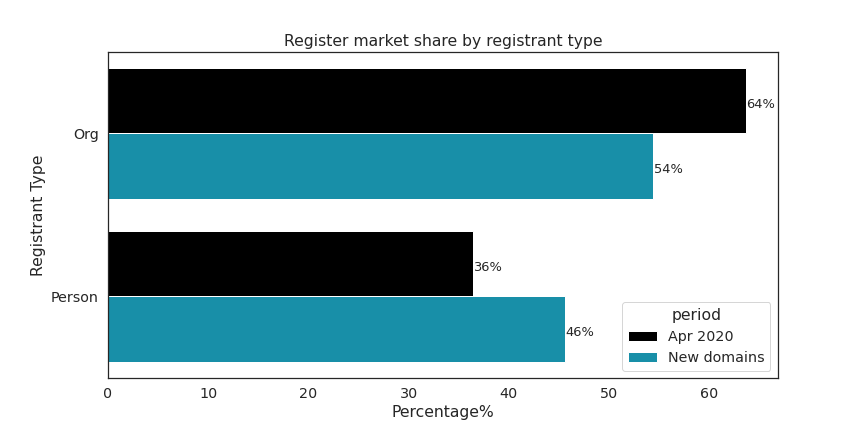
There were 190,000 organisations and 123,000 individuals in April. From April to October, there were 29,000 new registrants, representing 9.2% of the total. Among the new domains, half of them were owned by new registrants.
The preferred space variation
Within .nz, registrants have the choice to get their domain directly under .nz or in one of the second levels such as co.nz, org.nz or net.nz. Historically, co.nz concentrated most of the registrations, however in the period between April and October,
.nz had the highest market share growth with a 0.49% increase and co.nz had the highest share loss with a 0.24% loss. This reflects a trend where more and more new registrations are preferring to go directly to .nz.
Registrars
The majority of the registrars lost market share from Apr to Oct. We saw a small number of registrars dominating the market. The registration growth likewise comes from just a few registrars. As shown below in Figure 2, the top 5 registrars with the largest market share also drove the main growth from Apr to Oct. These top registrars also have a high number of domains transferred to them, representing 86% of the total transferred domains.
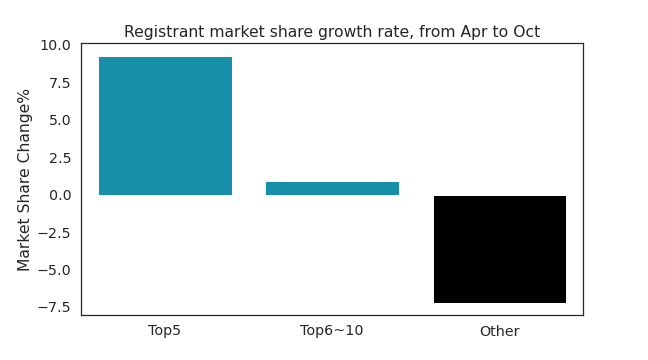
Lost domains
Despite having a growth of 2.1% in a semester, about 8% of the register was lost from Apr to Oct. 10% of registrants lost some of their domains and 5.9% of registrants lost all their domains, representing 23,000 of total domains. The lost domains had a relatively shorter life, compared to the overall domains as shown below in Figure 3.
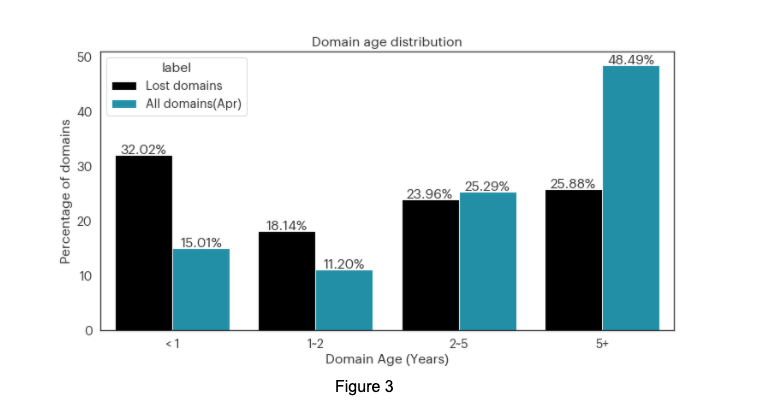
Locations
Registrations for .nz domains are not constrained to people and organisations within New Zealand, by October 2020, 18% of the registrations come from overseas. With a majority of domains held by New Zealand registrants, it’s not strange to see the country had the highest market share growth (0.69%), followed by the USA (0.05%) and India (0.02%). Portugal has the highest market share loss (-0.54%).
As New Zealand has the highest market share growth, it makes sense that New Zealand cities also have the highest growth among all cities in the world, with four of the top five highest growth cities coming from New Zealand. However, we saw that New York was number three, below Palmerston North and Havelock North. “tiny”, and “house” are popular keywords for new domains created in New York. According to ABC news, demands on tiny houses have doubled as many people have lost part of their income due to COVID-19. In the past, tiny houses were the choice for low-income earners who were looking for affordable housing. Now it is important for middle-income earners. There has also been strong interest from city-dwellers looking to live a more isolated life post-pandemic.
Domain name keyword analysis
We extracted domain names for keywords analysis. For example, for the domain “onlineshop.co.nz”, “onlineshop” was extracted and broken into keywords “online” and “shop.” This gave us a keyword corpus from all domains. We then calculated the number of domains containing each of the keywords. The heatmap in Figure 4 shows the number of domains matching the top 15 popular keywords by April.
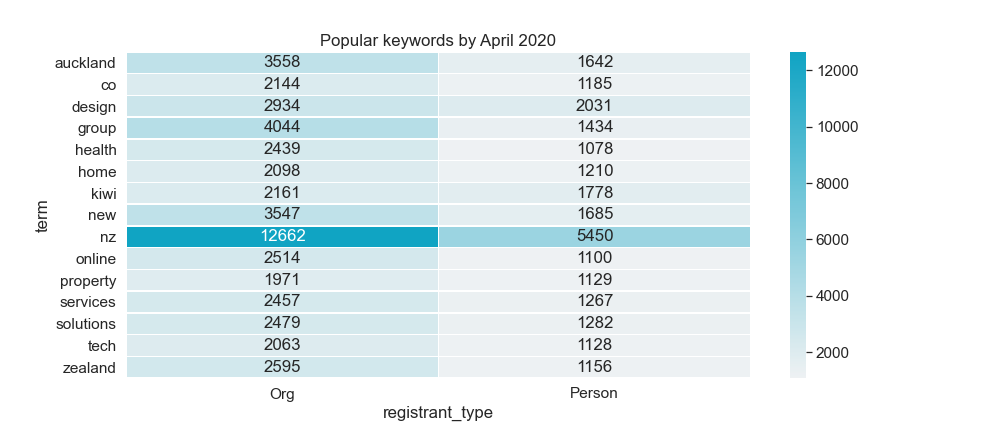
New domains data, however, showed interesting changes. As shown in Figure 5, we found that individuals were relatively more active and they were especially focused on “tiny”, “house” and “homes” related topics.
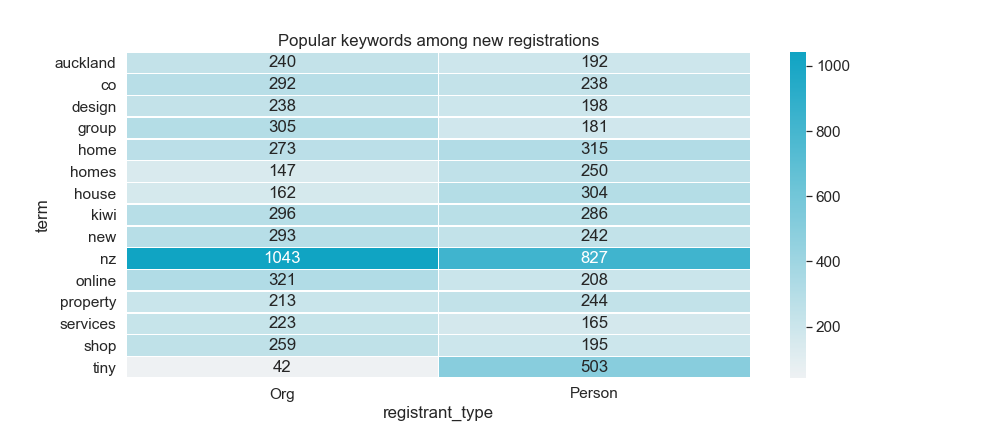
Summary
We took a data snapshot on 1t April 2020 as the baseline and compared it with a data screenshot on 1st October 2020. The main takeaways from this analysis were:
- There was a 2.1% growth of domains.
- Individuals were more active in terms of creating new domains.
- A small number of registrars own the majority of domains and drove the growth.
- There is a strong preference for registrants to use “.nz” directly instead of “co.nz”